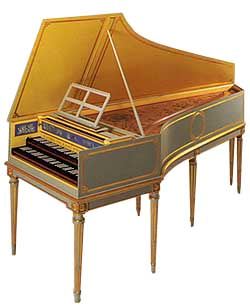|
Question: So what should I buy??
Answer: Let me ask the questions for a minute.
What kind of music do you play?
Your musical ambitions and desires help determine the right choice for you. Whether you like to play solo or continuo, early, baroque, chamber, contemporary or jazz, the following factors should help you focus your thinking.
Number of Keys
Clavichords have about 3-5 octaves, virginals, 4-5. Most harpsichords have between 4-5 octaves, also, and may have one, two, or, would you believe, three manuals (keyboards). Check the requirements of your repertoire. REMEMBER when I was studying harpsichord, we were never allowed to have an instrument that didn't have at least 5 octaves and 2 manuals. At this moment, I'm talking to the serious student and player. I had to say that because it's true.
Sound and Action
By now, you should be able to think about the type of instrument that is appropriate for your needs. If not, that's OK, too. The sound and action vary tremendously between the historical styles and from maker to maker. The only way to choose is by playing as many instruments as you can. The real truth is players know! When a person switches from piano to harpsichord (which is how it happens, because nobody grows up with a harpsichord in their house [except my son Hunter, who is not a harpsichordist ... not yet, anyway]), it takes lots of time of playing a harpsichord and then another harpsichord, and ANOTHER HARPSICHORD, and one day it feels natural to play a harpsichord, and then you know what a harpsichord is, and then you know the difference between one harpsichord and another. Go with your maestro, find one, find two, find three! I'm serious.
How much can you spend?
You generally get what you pay for. On the other hand, since I said this 6 years ago, I've changed my mind. Now it seems that isn't necessarily so. The most inexpensive and used instruments can be firewood in disguise, so be very careful with "bargain" instruments. At the other end of the scale, the most elaborately decorated custom instruments can cost over $50,000 (US). The broad midrange can be disorderly, with some good used instruments costing more than similar new custom jobs. It is safe to say that, much like wedding cakes, the more frills in decoration the greater the cost of the product. When it comes down to it (and I am serious), the instrument is either good or bad; don't buy a bargain, because you lose. I can't help you with that, but I can give you the following advice. Get a good one, and if you don't have the money to buy it, save up for it and wait. And in return for all this information, promise me you will get it, so when I come to play in your town, I can rent it from you.
Question: So how do I know if it is a quality instrument?
Answer: If you are ready to make an investment of this size, you want to know that it will last for generations. It either lasts for a day or two, or it lasts way beyond your lifetime. And do not trust everything you hear on the Internet. You have to talk to a player, and find out if the maker's instrument holds up to practicing and concert conditions. And don't ever underestimate yourself. You need the same kind of instrument because if it doesn't function, you can't play it.
Question: How much maintenance is required?
Answer: Harpsichords need to be played regularly!!
Regarding climate... everybody wants to know about climate. I want to discuss consistency in humidity levels. If you live, say, in Arizona, I would assume the humidity level indoors (which is where I would assume your harpsichord lives) is naturally dry, and we would want to keep it that way, so if you have a sudden rainstorm and the humidity rises to 50%, you have to do a tuning. If you live in New York City, the indoor humidity with the steam heat in the winter will give you a low indoor humidity level, and you will need to have a humidifier, to keep yourself at about 45%. Just listen, keep it steady, and don't shock it. Learn how to tune (or marry a tuner -- it has happened).
|
|
|
